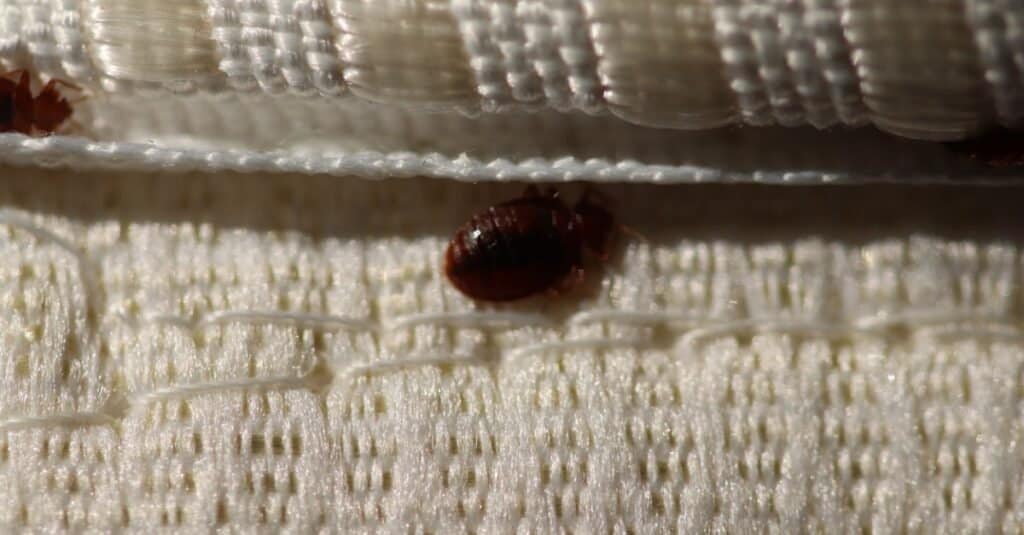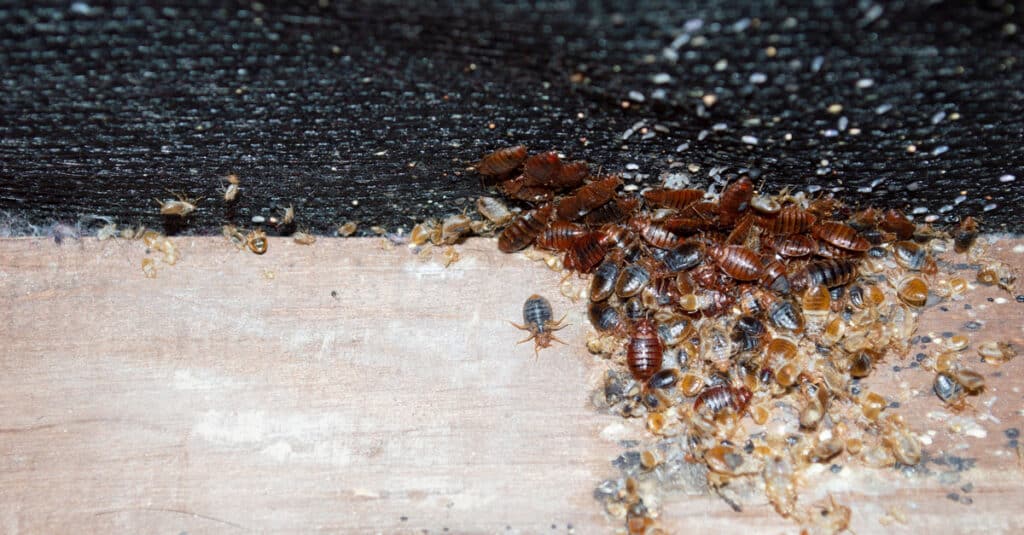Do bed bugs jump? No, bed bugs do not jump. Unlike crickets or grasshoppers, bed bugs don’t have the strong back legs required to propel themselves off the ground. But despite being unable to jump, bed bugs are able to reach a variety of areas in a home, hotel, college dormitory, and other locations.
Learn how bed bugs get around, where they are found, how fast they can move, and more!
What Do Bed Bugs Look for in a New Home?
Two things are especially appealing to bed bugs when they are looking for a new home. One of those things is access to humans. These bugs are parasitic and live on human blood. As a note, they sometimes drink animal blood from pet dogs or cats in a household. The second thing bed bugs want is a dark place to hide and multiply.
What Are Some Hiding Places of Bed Bugs?
One of the most common places to find bed bugs is in the seams of a mattress or box spring. When you think about it this makes sense. Bed bugs that make their home in a bed have regular access to the humans who sleep there every night.
Bed bugs can live in the joints of furniture such as tables, dressers, and bed frames. They live in rugs, carpeting, and window curtains.
Some of the lesser-known hiding places of bed bugs include behind the plates of electrical switches and outlets, beneath table legs, behind baseboards, and in the joints of picture frames. These tiny creatures are experts at finding places where they can hide without being disturbed.

©iStock.com/Matteo Lanciano
Do Bed Bugs Cause Damage to Furniture?
These bugs live in tables, bed frames, dresser drawers, and more. This may lead a person to believe these pests chew through and destroy wood furniture or even walls. Not true. Bed bugs don’t chew or eat wood.
How Do Bed Bugs Get into a Home?
When it comes to getting into a home, business, or other structure, bed bugs need a lot of help! People unknowingly bring bed bugs into a home via suitcases, bags, boxes, and even clothing. For example, a few bed bugs may hide in the pocket of a gym bag dropped onto the floor of a room. The pests crawl out of the bag and take up residence in the bed frame, in the joint of a bedside table, or in a pile of clothing on the floor. It’s sometimes a very easy journey for a bed bug.
This is why hotels are so vulnerable to bed bug infestation. Dozens of people check into and out of hotel rooms every week. They bring bags and suitcases that may or may not contain bed bugs. In other words, the chances of an infestation increase simply due to the sheer number of people who visit hotels. It takes just one guest with these pests to cause an issue for many rooms in a hotel.
How Do Bed Bugs Travel from Room to Room in a Home?
Just because bed bugs don’t jump doesn’t mean they can’t move easily from room to room in a home. Bed bugs get around by crawling. For instance, they get up into the sheets and blankets of a bed by crawling up the base of the bed’s frame. These bugs are able to crawl up walls, table legs, and more in order to get where they want to go.
How Fast Can Bed Bugs Travel?
Bed bugs are not only good at crawling up walls and table legs, but they can also crawl at a fast pace. One of the most incredible facts about bed bugs is they can crawl a distance of three feet in about one minute.
Another interesting fact about bed bugs is that they have vestigial wings (actually just wing pads) that the insects lost due to evolution. As the bugs became less reliant on their wings to access food, the wings became unneeded, and today they no longer have them in a usable form. This is a similar adaptation of some other household pests, like the cockroach.
What is the Food Source of Bed Bugs?
Bed bugs drink the blood of humans and sometimes animals. A bed bug that’s just fed on blood takes on a darker brown or red color. Plus, its body may become elongated with the intake of blood. Identification of an adult bed bug is easier after it has consumed a recent meal of blood.
Baby bed bugs also called nymphs, are white or ivory because they haven’t yet fed on blood.
Can I See Bed Bugs?
The answer is it depends on the growth stage of the bed bug. For instance, in terms of identification, a bed bug egg is the size of a grain of rice. These eggs are oblong and white which makes them very difficult to see on a white sheet or cushion. A professional bed bug exterminator may use a magnifying glass or even special goggles when examining a home for these pests.
Baby bed bugs are called nymphs. They are white and about a millimeter in length. Like bed bug eggs, nymphs are difficult for humans to see with the naked eye.
Adult bed bugs are comparable in size to watermelon seeds. They are brown or rust in color. So, when it comes to identification, an adult bed bug is the easiest to see out of all stages in this pest’s life cycle.
Do Bed Bugs Jump Like Fleas?
No. Bed bugs don’t jump at all. Alternatively, fleas can jump as well as crawl on animals and people. But fleas do have a significant characteristic in common with bed bugs.
Both fleas and bed bugs survive on blood. Fleas will sometimes bite humans, but usually, bite dogs and cats in order to get blood. Bed bugs tend to bite and suck blood from humans.

©simon berenyi/Shutterstock.com
What Can a Person Do to Prevent Bed Bugs in a Home?
The first step to removing bed bugs at home is to consult our guide to getting rid of bed bugs. We recommend a multi step approach that includes all of the items below.
 Check Amazon
Check Amazon- USDA BioBased formula is child and pet friendly
- 100% effective per recent study
- Kills bed bugs at all stages - adults, nymphs, and eggs
 Check Amazon
Check Amazon- Effective encasement against bed bugs
- Waterproof - doubles as a mattress protector
- Invisi-Zip and SureSeal enclosure ensures no bed bug entry
- 100% Cotton top - free from phthalates and other unhealthy chemicals
 Check Amazon
Check Amazon- No chemical option to confirm bed bug presence
- Catches other bugs and pests as well
- Easy detection coverage for 2-3 rooms.
 Check Amazon
Check Amazon- No chemical solution to block bed bugs
- Easy application
- Effective blockers for other pests like spiders
 Check Amazon
Check Amazon- 10 inch gel mattress is very comfortable
- Easy to apply encasement compared to wood frame mattresses
- Fast shipment and easy to install vs traditional optionss
 Check Amazon
Check Amazon- Powerful 10Kpa suction sucks up dust mites
- Specialized design for cleaning mattresses
- UV lamp eliminates moisture and kills bacteria
One of the most pertinent facts to remember is these pests try to stay away from the light. They come out at night to look for food. So, adding more natural light to a home can be one way to prevent an infestation of bed bugs. Opening the curtains, putting in a skylight, and moving furniture out from in front of the windows are all simple things that can be done to enhance natural light. This means there are fewer places for bed bugs to hide during the day.
Make it a habit to empty and clean suitcases and overnight bags in the garage or even outdoors. So, whenever a family member returns from a trip, don’t bring the suitcases or bags into the home. Instead, inspect and clean them outside to prevent any bed bugs from gaining entry to your home. This process is a little bit of a hassle, but it’s definitely easier than trying to get rid of an infestation of bed bugs!
Reducing all types of clutter around a home is another way to prevent these pests from invading. Incidentally, bed bugs are not found exclusively in uncleanly environments. On the contrary, they have invaded very clean homes and businesses. However, bed bugs are going to stay and multiply in a place with plenty of food and lots of hiding places. So, a home or business with piles of boxes, bags and other clutter is going to be attractive to these pests.
What Are the Benefits of Calling a Professional to Remove Bed Bugs?
Of course, there’s no shortage of DIY ways to get rid of a bed bug infestation. But there are benefits to calling in a professional if you have a bed bug infestation.
A professional bed bug exterminator has special knowledge regarding this pest. Along with all of the usual hiding places, bed bug exterminators are familiar with other places in a home or business where bed bugs hide. This is important because any eggs or bed bug nymphs overlooked during treatment can cause a re-infestation.
A second benefit of contacting a professional bed bug exterminator is they have the equipment necessary to get rid of these pests. This means the professional is able to do a thorough job of finding and getting rid of all eggs, nymphs, and adult bed bugs.
Some professional bed bug exterminators use natural solutions to get rid of an infestation. It’s a good idea to research the methods and treatments of a professional exterminator before calling the person in. You want to know all of the facts before the treatment begins. Using natural solutions to get rid of bed bugs protects members of the household as well as the pets living there.
When you call in a professional bed bug exterminator you get the benefit of a follow-up appointment. So, if you see bed bugs a few days or weeks after the treatment, you can contact the professional to come in and recheck the space. A reputable bed bug exterminator won’t consider the job done until all of the bed bugs and their eggs are gone from a home or business.
Up Next:
- Do Bed Bugs Fly? Okay, so bed bugs don’t jump. But can they fly? That’s a scary thought!
- Carpet Beetle vs Bed Bug: What are the Differences? These two can sometimes be confused, and it is important to know the difference in order to get rid of them.
- Bed Bug Bites: What Do They Look Like? Do you have some suspect bites? Find out right away if they are from these little pests.
The photo featured at the top of this post is © D. Kucharski K. Kucharska/Shutterstock.com
Thank you for reading! Have some feedback for us? Contact the AZ Animals editorial team.






